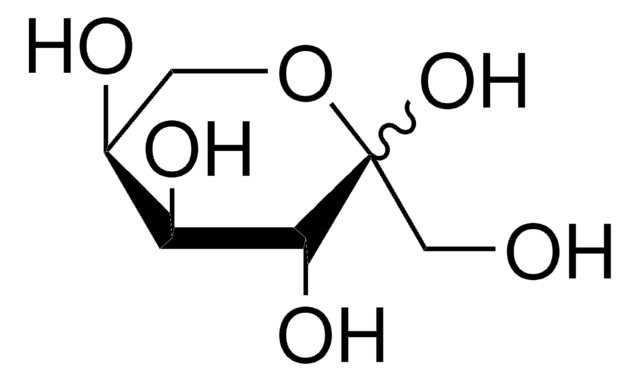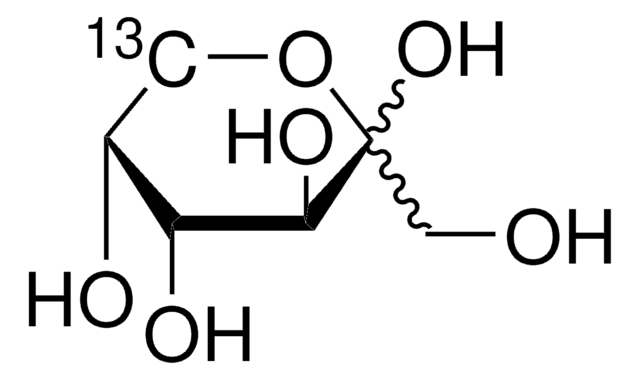Wichtige Dokumente
F2543
D-(−)-Fructose
≥99% (HPLC), BioXtra
Synonym(e):
D-Levulose, Fruchtzucker
About This Item
Empfohlene Produkte
Biologische Quelle
corn
Qualitätsniveau
Produktlinie
BioXtra
Assay
≥99% (HPLC)
Form
powder
Methode(n)
HPLC: suitable
Verunreinigungen
<0.0005% Phosphorus (P)
<0.05% glucose (enzymatic)
<0.1% Insoluble matter
Glührückstand
<0.1%
Farbe
colorless
Nützlicher pH-Bereich
5.0-7.0 (25 °C, 18 g/L)
mp (Schmelzpunkt)
119-122 °C (dec.) (lit.)
Löslichkeit
H2O: 1 M, clear, colorless
Anionenspuren
chloride (Cl-): <0.05%
sulfate (SO42-): <0.05%
Kationenspuren
Al: <0.0005%
Ca: <0.0005%
Cu: <0.0005%
Fe: <0.0005%
K: <0.005%
Mg: <0.0005%
NH4+: <0.05%
Na: <0.005%
Pb: <0.001%
Zn: <0.0005%
SMILES String
OC[C@@H](O)[C@@H](O)[C@H](O)C(=O)CO
InChI
1S/C6H12O6/c7-1-3(9)5(11)6(12)4(10)2-8/h3,5-9,11-12H,1-2H2/t3-,5-,6-/m1/s1
InChIKey
BJHIKXHVCXFQLS-UYFOZJQFSA-N
Suchen Sie nach ähnlichen Produkten? Aufrufen Leitfaden zum Produktvergleich
Allgemeine Beschreibung
Anwendung
<li><strong>Intracellular metabolomics and microRNAomics unveil new insight into the regulatory network for potential biocontrol mechanism of stress-tolerant Tricho-fusants interacting with phytopathogen Sclerotium rolfsii Sacc.</strong>: Explores the intracellular metabolomic and microRNAomic responses in Tricho-fusants, with D-(-)-Fructose identified as a key metabolite in stress tolerance and biocontrol mechanisms (Hirpara Gajera, 2023).</li>
<li><strong>Enzyme-based amperometric biosensors: 60 years later … Quo Vadis </strong>: Reviews advancements in enzyme-based biosensors over the past six decades, including the use of D-(-)-Fructose in the development of new biosensing technologies for clinical and environmental applications (Bollella, 2022).</li>
</ul>
Sonstige Hinweise
Anwendung
Lagerklassenschlüssel
11 - Combustible Solids
WGK
WGK 1
Flammpunkt (°F)
Not applicable
Flammpunkt (°C)
Not applicable
Persönliche Schutzausrüstung
Eyeshields, Gloves, type N95 (US)
Hier finden Sie alle aktuellen Versionen:
Besitzen Sie dieses Produkt bereits?
In der Dokumentenbibliothek finden Sie die Dokumentation zu den Produkten, die Sie kürzlich erworben haben.
Kunden haben sich ebenfalls angesehen
Chromatograms
application for HPLCUnser Team von Wissenschaftlern verfügt über Erfahrung in allen Forschungsbereichen einschließlich Life Science, Materialwissenschaften, chemischer Synthese, Chromatographie, Analytik und vielen mehr..
Setzen Sie sich mit dem technischen Dienst in Verbindung.






